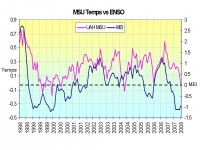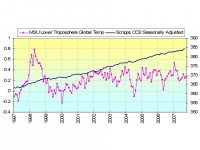By Joseph D’Aleo, CCM
Early in January 2007, the Phil Jones of the UK Hadley center predicted that 2007 would be the warmest on record due to the El Nino, which some scientists including Hansen predicted could be the strongest in history. Well of course the El Nino quickly faded and La Nina slowly came on during 2007. Temperatures globally cooled, starting in the Southern Hemisphere winter and then transitioning into the Northern Hemisphere winter. At the end of the year, the Hadley center announced it was the 7th warmest, blaming the oncoming La Nina for the cooling and busted forecast. This January, MSU satellite data indicated the globe was cooler than the 1979-98 average for the first time in years.
With the recent global cooling that is the result of the moderate to strong La Nina, I thought I would again look at the last decade and see how well the global temperatures reacted to the transition from a super El Nino in 1997/98 to La Ninas from 1998 to 2000/2001, an El Nino in 2002/03 and borderline El Ninos in 2003/04 and 2004/05 and again 2006/07 followed by the return of La Nina in 2007/08/. I used the MSU lower tropospheric temperatures and the Multivariate ENSO Index of Wolter.

Temperatures track well with the ENSO state as indicated by the MEI. There is an apparent lag of 2 or more months of temperature to the MEI. With a 2 year lag applied, the Pearson correlation of the raw (unsmoothed data sets) is 0.67 (r-squared of 0.45). For the same time period, the CO2 correlation is only 0.07 (r-squared of 0.005).

See how the ENSO (El Nino and La Nina) frequency relates to the Pacific Decadal Oscillation which has turned negative here. As to whether this strong La Nina and strongly negative PDO this winter marks the start of the new cold period or just another false alarm like 1998-2001, the next year or so will tell. The last three PDO phases each lasted 25-30 years and we are 30 years since the last change called the Great Pacific Climate Shift so it appears this time, the change may be for real. If indeed the sun which many solar scientists believe is about to go into a quiet mode seen only seen every 200 to 400 years, is much weaker this upcoming cycle, this may be very interesting indeed.




